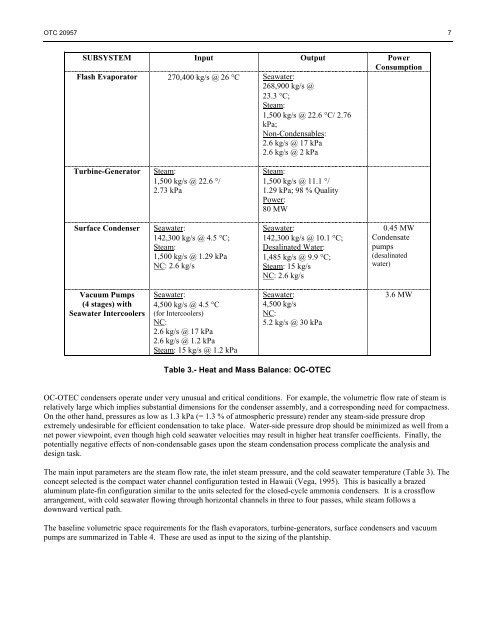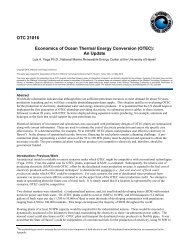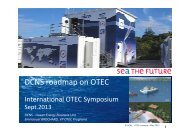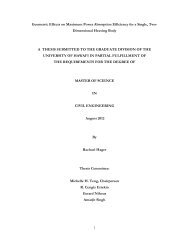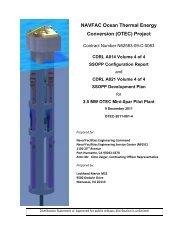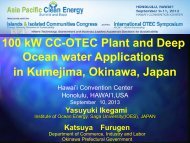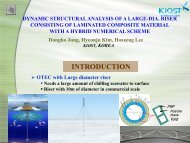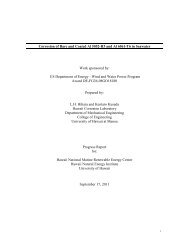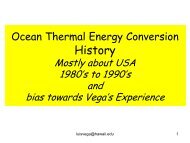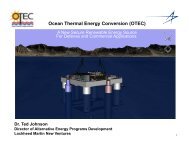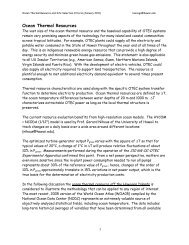50 MW OTEC Plantship Design - Hawaii National Marine ...
50 MW OTEC Plantship Design - Hawaii National Marine ...
50 MW OTEC Plantship Design - Hawaii National Marine ...
Create successful ePaper yourself
Turn your PDF publications into a flip-book with our unique Google optimized e-Paper software.
OTC 20957 7<br />
SUBSYSTEM Input Output Power<br />
Consumption<br />
Flash Evaporator 270,400 kg/s @ 26 °C Seawater:<br />
268,900 kg/s @<br />
23.3 °C;<br />
Steam:<br />
1,<strong>50</strong>0 kg/s @ 22.6 °C/ 2.76<br />
kPa;<br />
Non-Condensables:<br />
2.6 kg/s @ 17 kPa<br />
2.6 kg/s @ 2 kPa<br />
Turbine-Generator<br />
Steam:<br />
1,<strong>50</strong>0 kg/s @ 22.6 °/<br />
2.73 kPa<br />
Steam:<br />
1,<strong>50</strong>0 kg/s @ 11.1 °/<br />
1.29 kPa; 98 % Quality<br />
Power:<br />
80 <strong>MW</strong><br />
Surface Condenser<br />
Seawater:<br />
142,300 kg/s @ 4.5 °C;<br />
Steam:<br />
1,<strong>50</strong>0 kg/s @ 1.29 kPa<br />
NC: 2.6 kg/s<br />
Seawater:<br />
142,300 kg/s @ 10.1 °C;<br />
Desalinated Water:<br />
1,485 kg/s @ 9.9 °C;<br />
Steam: 15 kg/s<br />
NC: 2.6 kg/s<br />
0.45 <strong>MW</strong><br />
Condensate<br />
pumps<br />
(desalinated<br />
water)<br />
Vacuum Pumps<br />
(4 stages) with<br />
Seawater Intercoolers<br />
Seawater:<br />
4,<strong>50</strong>0 kg/s @ 4.5 °C<br />
(for Intercoolers)<br />
NC:<br />
2.6 kg/s @ 17 kPa<br />
2.6 kg/s @ 1.2 kPa<br />
Steam: 15 kg/s @ 1.2 kPa<br />
Seawater:<br />
4,<strong>50</strong>0 kg/s<br />
NC:<br />
5.2 kg/s @ 30 kPa<br />
3.6 <strong>MW</strong><br />
Table 3.- Heat and Mass Balance: OC-<strong>OTEC</strong><br />
OC-<strong>OTEC</strong> condensers operate under very unusual and critical conditions. For example, the volumetric flow rate of steam is<br />
relatively large which implies substantial dimensions for the condenser assembly, and a corresponding need for compactness.<br />
On the other hand, pressures as low as 1.3 kPa (= 1.3 % of atmospheric pressure) render any steam-side pressure drop<br />
extremely undesirable for efficient condensation to take place. Water-side pressure drop should be minimized as well from a<br />
net power viewpoint, even though high cold seawater velocities may result in higher heat transfer coefficients. Finally, the<br />
potentially negative effects of non-condensable gases upon the steam condensation process complicate the analysis and<br />
design task.<br />
The main input parameters are the steam flow rate, the inlet steam pressure, and the cold seawater temperature (Table 3). The<br />
concept selected is the compact water channel configuration tested in <strong>Hawaii</strong> (Vega, 1995). This is basically a brazed<br />
aluminum plate-fin configuration similar to the units selected for the closed-cycle ammonia condensers. It is a crossflow<br />
arrangement, with cold seawater flowing through horizontal channels in three to four passes, while steam follows a<br />
downward vertical path.<br />
The baseline volumetric space requirements for the flash evaporators, turbine-generators, surface condensers and vacuum<br />
pumps are summarized in Table 4. These are used as input to the sizing of the plantship.


